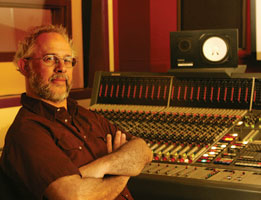|
|
Emulating Sliding Piatti |
March 2005 |
|
I think most electronic musicians will agree that synthesized and sampled emulations of acoustic instruments just don't sound like the real thing. That shouldn't come as a shock since, in fact, samples aren't the real thing. Still, as technology improves, we are increasingly able to accurately emulate that ĺ─˙liveĺ─¨ sound. And the closer we come, the more painfully we are aware that we haven't quite nailed it yet.
We can make emulated instruments sound a lot better with higher-quality synths and sampling tools and more advanced signal processors, such as convolution reverbs. Improved home-theater sound systems allow our customers to more accurately hear the music. (I am sure the irony is not lost on most readers that we finally have tools that allow us to make sonically excellent digital recordings, but consumers have migrated in droves to lossy MP3-format recordings and low-bandwidth earbuds.) But a lot of the problem with respect to synthesized and sampled acoustic instruments is that we rarely can play electronic instruments with the detailed nuances that acoustic instruments afford.
One problem involves electronic musical-instrument design. How can manufacturers deliver instruments that are more expressive, easier to use, don't require the performer to be a technical expert, and are commercially viable? We'll probably address that issue in a future column, either in ĺ─˙First Takeĺ─¨ or in ĺ─˙Final Mix,ĺ─¨ or both.
However, we musicians can make synthesized or sampled acoustic and electroacoustic instruments sound more like the real thing by emulating the performance techniques and timbral nuances employed when playing the instrument being emulated. If you've ever tried to use samples to play rock 'n' roll or R&B sax parts, complete with performance effects, you know that can be a mighty steep hill to climb.
But in many cases, if you understand how the instrument being emulated is constructed, how it is played, and how it is commonly used in different musical contexts, you can make synthesized and sampled acoustic instruments sound a lot closer to the real deal than you might think. It takes careful sound programming and a good knowledge of sequencing, especially with respect to using MIDI continuous controllers, but that's time well invested.
We at EM have thought about these questions for many years, and we have addressed it as recently as our February 2003 issue (see ĺ─˙Emulating the Real Thingĺ─¨ in our article archives at www.emusician.com). But there is far more to be said on the subject than we could present in one story. So when new author David Pedergnana proposed a story on how to get more realistic results when using synthesized and sampled orchestral instruments, I was, as the saying goes, ĺ─˙all ears.ĺ─¨
Pedergnana is no slouch; he does a lot of film-scoring work with orchestral sounds and knows of what he speaks. And in ĺ─˙Subtle Gesturesĺ─¨ (p. 36), he speaks powerfully, offering a wealth of practical tips for improving many different types of emulated orchestral instruments using MIDI continuous controllers. If you read this story and don't learn something useful, either you didn't read it closely, or you are already a grandmaster. Besides, where else can you learn to emulate sliding piatti? |
